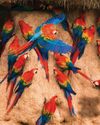
It’s a warm December morning off the coast of tropical Queensland and conditions are perfect for diving: a cloudless sky above; the ocean smoother than glass. Above the water, it’s a picture of stillness and serenity, but there’s a carnival of colour in full swing beneath the surface.
Shafts of sunlight cast dappling patterns across banks of coral that flash in shades of purple, pink and red. A school of fusilier fish rush past, yellow tails aglow, while a bright blue parrotfish lazily nibbles at the reef. On a towering wall of coral, two tiny clownfish, distinctive in their tangerine-and-white striped costumes, wriggle among the fluttering fingers of a sea anemone. For all the headlines about the declining health of the Great Barrier Reef, it looks in pretty good condition from where I’m floating.
The Great Barrier Reef is the world’s most famous underwater wonder, a UNESCO-listed system of nearly 3,000 individual coral reefs stretching for more than 2,250km off Australia’s Queensland coast. Each reef is made up of thousands to millions of tiny coral polyps, an animal whose external calcium carbonate skeleton forms the rock-like structure that gives the reef its shape – and provides food and shelter to nearly 9,000 known marine species.
Cruise experiences bring tourists up close and personal with some of those species, and back on a catamaran my fellow divers and I excitedly swap stories from a day spent trailing green turtles and shadowing reef sharks along cliffs of technicolour coral. But it’s the indigenous crew members running this particular tour who have the most important stories to tell.
Bu hikaye BBC Wildlife dergisinin June 2024 sayısından alınmıştır.
Start your 7-day Magzter GOLD free trial to access thousands of curated premium stories, and 9,000+ magazines and newspapers.
Already a subscriber ? Giriş Yap
Bu hikaye BBC Wildlife dergisinin June 2024 sayısından alınmıştır.
Start your 7-day Magzter GOLD free trial to access thousands of curated premium stories, and 9,000+ magazines and newspapers.
Already a subscriber? Giriş Yap

SNAP-CHAT
Justin Gilligan on giant spider crabs and holding hands with an octopus

STEPPE CHANGE
Herds of saiga have returned to Kazakhstan, but there's a fine balance to tread

TREES FOR LIFE
Community is at the heart of conservation in the tropical forests of southern Belize

WHEN DOVES CRY
Turtle doves are now the UK's fastest declining bird species, but the RSPB is on a mission to save them

SURVIVAL OF THE CUTEST
We can't help being drawn to cute creatures, but our aesthetic preferences both help and hinder conservation

LIGHT ON THE NORTH
Spectacular images of Arctic foxes, reindeer and musk oxen reveal the wild beauty and diversity of Scandinavia

ROLLING IN THE DEEP
The super-sized crustacean that lives in the deepest, darkest ocean

LET'S GET TOGETHER
Clay licks deep in the Amazon explode in a riot of colour, with macaws the stars of the show

FEMALE OF THE SPECIES
To sponge or not to sponge? That is the question for the bottlenose dolphins (Tursiops aduncus) living in Shark Bay, Western Australia.

7 nature encounters for the month ahead
WITH NATURALIST AND AUTHOR BEN HOARE